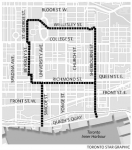
Councillor Denzil Minnan-Wong, who only recently learned how to ride a bike through CAN-Bike, has sprung on the public a plan to build a small network of separated bike lane downtown.
Minnan-Wong's plan, however, didn't appear in a vision to him. Last winter the Toronto Cycling Advisory Committee advised that Lower Sherbourne get separated bike lanes to coincide with the road resurfacing, as recommended by lawyer Alan Heisey and the Toronto Cyclists Union. The two then presented in August a petition calling for a plan to the public works committee, the same committee of which Minnan-Wong is now chair. In the petition the request was for filling in the gaps and separating a number of these lanes (see full petition):
- Connect the Simcoe Street bicycle lanes to the St George Beverley Street bicycle lanes via John Street and Richmond Street West so there is a continuous north-south bicycle lane route west of the core connecting Bloor Street to the Lake.
- Separate the Simcoe Street bicycle lanes from traffic between Front Street West and Queens Quay by bollards and or curbs.
- Complete and separate the Wellesley Street/Harbord Street bicycle lanes system and end the gaps in the system at Queens Park and on Harbord Street.
- lnstall separated bicycle lanes on either Richmond Street and/or Adelaide Street connecting Sherbourne Street and Bathurst Street.
- Ensure that the first phase of the Queen's Quay Pedestrian Promenade terminates at Bay Street and not York Street as it is currently intended.
It's always good politics when a councillor can take most of the credit for a good idea, and this is good politics.
As for good cycling infrastructure, this is a good start of what most cyclists have wanted. It doesn't hurt that the small network will cover roughly the same area as the initial service area of BIXI Toronto. This also coincides with the transportation staff's recommendation in their recent bicycle count report, which is to focus on improvements to existing bike lanes, particularly the College lanes which carry a large proportion of the bike traffic but suffers from endemic bike lane blocking.
I can't help feeling cynical about this. Minnan-Wong doesn't have a strong voting record on cycling infrastructure (though not nearly as bad as Mayor Ford's and Deputy Mayor Holyday's). Minnan-Wong voted against the separated bike lanes on University. Presumably he sees the current plan as much safer politically since most of the proposal already has bike lanes.
[img_assist|nid=4246|title=Alan Heisey: the guy with the ideas|desc=Courtesy of Toronto Star|link=none|align=center|width=500|height=328]
It appears that all the good ideas are coming ex-nihilo out of the mind of the likes of Minnan-Wong. It reinforces the idea that they don't need to listen to the transportation staff, and that they don't need to listen to the ideas coming from the cycling community. There still isn't a cycling committee, so presumably Minnan-Wong and the Mayor aren't entirely interested in strengthening the communication with cyclists. It may take some stronger pushing from the cycling community to get necessary infrastructure installed even where it will inevitably meet some local opposition. The mayor isn't known for balancing competing populist opinions, rather he seems to choose the populist notions that fit nicely into his own ideology. I can't see them pushing for a separated bike lane where it comes up against existing car parking or car lanes.
But, lest you accuse me of being a sourpuss, let me tell you that I like to go into these things with my eyes open but optimistic. Getting separated bike lanes - though controversial even with some cyclists - is a big win for cyclists, but we can't let the politicians figure they've finished their work. There are a lot of cyclists who will rarely benefit from this small network.

